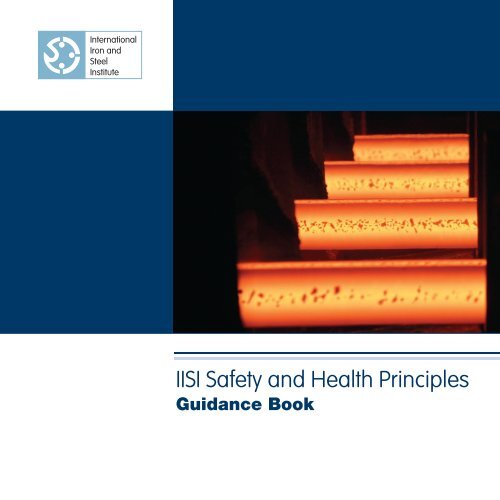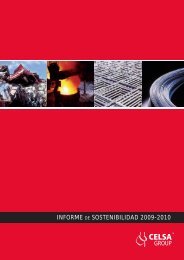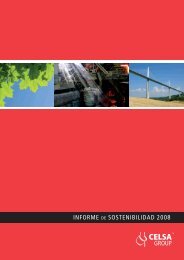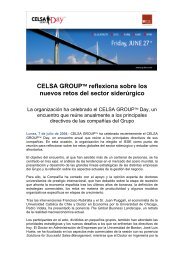Guidance Book - Celsa Group
Guidance Book - Celsa Group
Guidance Book - Celsa Group
Create successful ePaper yourself
Turn your PDF publications into a flip-book with our unique Google optimized e-Paper software.
�������������<br />
��������<br />
�����<br />
���������<br />
IISI Safety and Health Principles<br />
<strong>Guidance</strong> <strong>Book</strong>
2<br />
Contents<br />
Foreword .................................................................................................................. 3<br />
About the IISI Safety and Health Principles............................................................ 5<br />
Our commitment ......................................................................................................7<br />
The principles ........................................................................................................... 9<br />
The principles for a global industry: in Chinese, Czech, Dutch,<br />
Finnish, French, Japanese, Korean, and Russian .............................................. 20<br />
Credits ..................................................................................................................... 22
Foreword<br />
In October 2006, the International Iron and Steel Institute (IISI) Board of Directors<br />
endorsed a new set of safety and health principles. The Board strongly<br />
believes that clearly-defi ned principles will result in improved safety and health<br />
performance, as well as better business results across the industry.<br />
IISI has developed this guidance book to encourage member companies to apply<br />
the principles.<br />
Through the adoption of these principles at the highest level, IISI and its members<br />
demonstrate their commitment to an injury-free, illness-free and healthy<br />
workplace.<br />
Ku-Taek Lee<br />
Chairman IISI<br />
Chairman and CEO, POSCO<br />
Lakshmi Mittal<br />
Vice-Chairman IISI<br />
CEO and President of the Board of<br />
Directors, ArcelorMittal<br />
Paolo Rocca<br />
Vice-Chairman IISI<br />
CEO and President, Techint <strong>Group</strong><br />
John Surma<br />
Vice-Chairman IISI<br />
Chairman and CEO, United States Steel<br />
Corporation<br />
3
About the IISI Safety and<br />
Health Principles<br />
The IISI policy statement on safety and health lays out the basic principles drawn<br />
up by the IISI Safety and Health Committee. The principles are based on the<br />
experience, knowledge, company policies and values of the members of the<br />
working group.<br />
The policy promotes excellence in safety and health practices. The set of principles<br />
it contains was established to demonstrate and communicate to internal and<br />
external stakeholders the priority that the industry places on its safety and health<br />
performance. It aims to elevate standards across the industry, to achieve an<br />
accident-free steel industry.<br />
The goal is zero: an injury-free, illness-free and healthy workplace.<br />
Through the adoption of these principles, IISI member companies all over the<br />
world will have a basis for creating a safe and healthy work environment for<br />
everyone who works in the industry.<br />
Note: This booklet provides guidance to IISI members on the meaning of the<br />
principles. Individual companies have different goals and procedures. The<br />
principles have to be adapted to meet differing cultural, social and corporate<br />
environments.<br />
The policy promotes<br />
excellence in safety and<br />
health practices.<br />
5
Our commitment<br />
“Nothing is more important than the<br />
safety and health of people who work in<br />
the iron and steel industry.”<br />
The safety and health of our people is our core value and will not be compromised<br />
in the face of other business issues. This applies to everyone involved in the<br />
industry, be they employees, service providers (contractors) or others such as<br />
suppliers, customers and visitors.<br />
The industry is committed to the goal of an injury-free, illness-free and healthy<br />
workplace.<br />
Is safety and health the highest priority in your company? If so, is this refl ected<br />
in your mission statement?<br />
The industry is committed<br />
to the goal of an<br />
injury-free, illness-free and<br />
healthy workplace.<br />
7
8<br />
Injuries and illnesses must not<br />
be considered a normal part<br />
of our industry.
The principles<br />
“All injuries and work-related illness can<br />
and must be prevented.”<br />
We will do everything we can, consistent with world class practices, to prevent<br />
injuries and illnesses.<br />
Injuries and illnesses must not be considered a normal part of our industry.<br />
Everyone has a responsibility to prevent injuries and illnesses; it is only by working<br />
together that we will achieve a safe and healthy workplace.<br />
Investigating and learning from accidents (with or without injury) will help prevent<br />
the recurrence of such events. Knowledge from the lessons learnt will help the<br />
whole industry to protect people and avoid situations that threaten safety or<br />
health.<br />
Implement a safety management system that includes risk assessment and<br />
hazard identifi cation and control to prevent injuries and illnesses.<br />
Risk assessment:<br />
All risks should be assessed to determine what kinds of injury or illness they<br />
could cause. There are many ways to do a risk assessment. In the book ‘Safety<br />
and health in the iron and steel industry’, published by the International Labour<br />
Offi ce, you will fi nd explanations about hazard identifi cation, risk assessment and<br />
control.<br />
IISI offers member companies the opportunity to share ‘Alerts’. These are incident<br />
reports that contain information such as the cause of the incident and key<br />
learnings. You can see the Alerts on the Accident Free Steel 2 website, on the<br />
IISI Extranet. All employees of IISI member companies are entitled to access the<br />
Extranet.<br />
Principle 1<br />
9
10<br />
If the leaders do not visibly<br />
change, nothing will.
“Managers are responsible and<br />
accountable for safety and health<br />
performance.”<br />
This includes everyone from company executives to front-line leaders.<br />
It is essential that managers are seen to support safety and health initiatives in a<br />
consistent way. It lends credibility and thoughtfulness to every task, big or small.<br />
By leading the initiatives consistently, managers demonstrate that<br />
shortcuts are not acceptable.<br />
If the leaders do not visibly change, nothing will. Managers should set priorities,<br />
establish goals and seek and provide resources for safety and health matters.<br />
This active involvement shows that there is a genuine desire to see each effort<br />
succeed.<br />
Include safety and health results in performance assessments and other<br />
career advancement decisions.<br />
It is important to note that this principle does not contradict the later principle<br />
stating that working safely is a condition of employment. All employees are<br />
responsible for their personal safety and that of co-workers, and must comply with<br />
all relevant safety and health rules.<br />
Principle 2<br />
11
12<br />
Engaged and empowered<br />
employees will choose to<br />
work safely.
“Employee engagement and training is<br />
essential.”<br />
Everyone must be involved in a meaningful way, on a daily basis, to support injury<br />
and illness prevention. Through constant exposure to safe practices, people will<br />
develop behaviour that ensures each task is safe.<br />
Engaged and empowered employees will choose to work safely. They will also<br />
feel comfortable to contribute their ideas for safety and health improvement.<br />
Involvement and recognition of the employee will promote good safety and health<br />
results.<br />
Training is an essential part of an effective safety and health system. All employees<br />
must have the necessary training, skills and tools to do their job safely. Employees<br />
need to show a willingness to be trained and to apply their acquired knowledge<br />
and skills. With the right training, each person can perform independent risk<br />
assessments.<br />
Employees must know how to keep themselves and those around them safe.<br />
Talk to your employees about accident and illness prevention every day. Are<br />
they aware of the inherent dangers associated with their jobs?<br />
Provide your employees with adequate training to protect themselves and<br />
their colleagues.<br />
Principle 3<br />
13
14<br />
Every employee is empowered<br />
to stop any work or process if<br />
they believe it to be unsafe or<br />
unhealthy.
“Working safely is a condition of<br />
employment”.<br />
By making safe work practices a condition of employment, we foster the<br />
importance of safety and health in the workplace.<br />
It is the responsibility of every employee to understand and comply with all<br />
relevant safety and health rules and safe work practices. Each individual<br />
employee must take personal responsibility for their own safety and health.<br />
Every employee is empowered to stop any work or process if they believe it to be<br />
unsafe or unhealthy. For many companies, there could be a substantial cultural<br />
barrier to such an action. It is a management responsibility to make sure that<br />
employees feel empowered and confi dent to take such a step.<br />
Everyone must be aware of the risks involved with their work. Encourage each<br />
person to think through their tasks and to take steps to identify and eliminate any<br />
risks.<br />
Upon arriving at work, and while at work, employees must be in a condition that<br />
will allow them to work safely.<br />
Does everyone on your site assess the risks of their job? What are the<br />
consequences if they do not?<br />
Principle 4<br />
15
16<br />
We should do what we say<br />
and say what we do.
“Excellence in safety and health drives<br />
excellent business results.”<br />
Caring about the well-being of our people is the essence of successful<br />
leadership. Good safety and health is good business and has a positive impact<br />
on employees. Engaging people in safety and health will contribute to improved<br />
business results.<br />
Prevention of injuries and illnesses creates a competitive advantage by having<br />
our most valuable resource – our people – at work. All resources are jeopardised<br />
by workplace accidents, which result in production losses and downtime for<br />
investigations. The costs of accidents (with or without injuries) and illnesses<br />
undermine competitiveness.<br />
A robust safety management system will help to reduce loss through incident<br />
prevention.<br />
Loss can include:<br />
• Loss of man hours<br />
• Loss of production time<br />
• Loss of process stability<br />
• Loss of plant or equipment<br />
• Loss of product<br />
• Loss of shareholder confi dence.<br />
To invest in safety and health is to improve productivity and performance. See<br />
page 9 of the IISI book ‘Accident Free Steel’ for more information on ‘the iceberg of<br />
incidents’.<br />
Principle 5<br />
17
18<br />
Bring safety and health to the<br />
forefront of all your business<br />
decisions and processes.
“Safety and health is integrated into all<br />
business management processes.”<br />
Safety and health should be included in all new and existing business processes,<br />
for example, managing assets, production, projects and administration. It should<br />
be reassessed before any changes are applied.<br />
When safety and health are consistently brought to the forefront of business<br />
decisions and processes, people develop an appreciation for the importance of<br />
the topic. People understand what is expected of them and have the knowledge<br />
to work safely.<br />
Before decisions are made, make an assessment of the safety and health<br />
implications. Involve different levels of people to ensure a thorough appraisal.<br />
Principle 6<br />
19
20<br />
The principles for a global industry<br />
The principles are available in Chinese, Czech, Dutch, Finnish, French, Japanese, Korean and Russian.<br />
“Niets is belangrijker<br />
dan de veiligheid en<br />
�������������<br />
��������<br />
�����<br />
���������<br />
de gezondheid van de mensen<br />
die in de staalindustrie werken.”<br />
IISI Raad van Bestuur, oktober 2006<br />
�������������<br />
��������<br />
�����<br />
���������<br />
“钢铁业中, 没有什么比员工的健康和<br />
安全更重要。”<br />
国际钢铁协会理事会, 2006年10月<br />
国际钢铁协会理事会和会员的信念:<br />
1 杜绝伤害事故, 远离职业疾病。<br />
2 健康安全根本, 领导关心负责。<br />
3 人人做出承诺, 积极参与培训。<br />
4 共创安全环境, 享受平安幸福。<br />
5 健康安全出色, 经营业绩卓越。<br />
6 管理环环相扣, 健康安全如一。<br />
Het bestuur en de leden van IISI geloven dat:<br />
1 Alle verwondingen en aan het werk gerelateerde ziektes kunnen en<br />
moeten voorkomen worden<br />
2 Het bestuur verantwoordelijk is voor de uitvoering van veiligheids- en<br />
gezondheidsmaatregelen<br />
3 De toewijding en de training van het personeel essentieel is<br />
4 Veilig werken tot de tewerkstellingsvoorwaarden behoort<br />
5 Uitmuntende bedrijfsresultaten het gevolg zijn van uitmuntendheid op<br />
vlak van veiligheid en gezondheid<br />
6 Veiligheid en gezondheid opgenomen moeten worden in alle<br />
besluitprocessen.<br />
Hoe staat jou bedrijf ervoor?<br />
“Není nic d ležit jšího<br />
než zdraví a bezpe nost<br />
práce lidí pracujících v hutním<br />
pr myslu.”<br />
Správní rada IISI, íjen 2006<br />
Správní rada a lenové IISI míní, že:<br />
1 Veškerým poškozením zdraví a nemocem majícím vztah k<br />
vykonávané práci musí být p edcházeno preventivn;<br />
2 Vedení je zodpov dné za dodržování bezpe nosti a ochrany<br />
zdraví p i práci;<br />
3 Angažovanost a školení pracovník je nezbytné;<br />
4 Pracovat bezpe n je podmínkou zam stnání;<br />
5 Dokonalost pi ochran zdraví a bezpe nosti práce vede k<br />
vynikajícím obchodním výsledk m;<br />
6 Ochrana zdraví a bezpe nost práce musí být sou ástí všech<br />
ídících proces podnikání.<br />
Jak je na tom vaše fi rma?<br />
”Mikään ei ole<br />
tärkeämpää<br />
terästeollisuudessa<br />
työskenteleville ihmisille kuin<br />
terveys ja turvallisuus.”<br />
IISI:n johtokunta, lokakuu 2006<br />
�������������<br />
��������<br />
�����<br />
���������<br />
�������������<br />
��������<br />
�����<br />
���������<br />
IISI:n johtokunnan jäsenet uskovat:<br />
1 Kaikki tapaturmat ja työperäiset sairaudet voidaan ja pitää estää<br />
2 Johto on vastuussa ja tulosvastuullinen työturvallisuustuloksista<br />
3 Työntekijän sitouttaminen ja opastaminen on oleellista<br />
4 Turvallinen työskentely on työsuhteen edellytys<br />
5 Erinomaisuus työturvallisuustyössä tukee erinomaisia<br />
liiketaloudellisia tuloksia<br />
6 Työturvallisuus täytyy integroida kaikkiin johtamisprosesseihin.<br />
Kuinka sinun liiketoimintasi menestyy?
22<br />
Credits<br />
This booklet was produced with input from the IISI Safety and Health Committee. IISI<br />
thanks ArcelorMittal, BlueScope Steel, Corus, Essar, Hüttenwerke Krupp Mannesmann,<br />
Novolipetsk Steel, Outokumpu, POSCO, Saudi Iron and Steel, ThyssenKrupp, US Steel and<br />
Wirtschaftsvereinigung Stahl for their photographs and other contributions.<br />
Photography:<br />
Cover image: ArcelorMittal<br />
Page 4: BlueScope Steel<br />
Page 6: BlueScope Steel<br />
Page 8: Hüttenwerke Krupp Mannesmann<br />
Page 10: ArcelorMittal<br />
Page 12: POSCO<br />
Page 14: Bluescope Steel<br />
Page 16: ThyssenKrupp<br />
Page 18: Novolipetsk Steel<br />
Concept and copyrights:<br />
International Iron and Steel Institute<br />
This publication is printed on Munken Lynx by Arctic Paper. All Arctic Paper mills are certifi ed<br />
to meet ISO 14001 standards for environmental management. Munken Lynx is also certifi ed<br />
by the Forest Stewardship Council as environmentally-responsible paper.
International Iron and Steel Institute (IISI)<br />
Rue Colonel Bourg 120<br />
1140 Brussels<br />
Belgium<br />
T: +32 2 702 89 00<br />
F: +32 2 702 88 99<br />
E: steel@iisi.be<br />
C303 Office Building<br />
Beijing Lufthansa Center<br />
50 Liangmaqiao Road<br />
Chaoyang District<br />
Beijing, China<br />
T: +86 10 6464 6733<br />
F: +86 10 6464 6744<br />
E: china@iisi.be<br />
worldsteel.org





